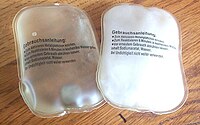
Photo from wikipedia
Microencapsulated phase change material (MPCM) composites of capric acid were synthesized utilizing protein (Gelatin, GE)-polysaccharide (Gum Arabic, GA) interactions as shell material. Mechanical and thermal stabilities of these MPCM composites… Click to show full abstract
Microencapsulated phase change material (MPCM) composites of capric acid were synthesized utilizing protein (Gelatin, GE)-polysaccharide (Gum Arabic, GA) interactions as shell material. Mechanical and thermal stabilities of these MPCM composites were achieved using glutaraldehyde cross-linker and silica coating respectively. Thermal properties (enthalpy and, melting/crystallization and cyclic tests) were estimated using differential scanning calorimeter (DSC) while, thermal stability was obtained from thermogravimetric analyzer (TGA). Morphology and particle size were analyzed using scanning electron microscope (SEM). FTIR and EDX (energy-dispersive X-ray) data interpreted nature of chemical bonds while crystalloid structures were obtained from XRD (X-Ray Diffraction). Based on morphology and thermal stability, the composite made with the core: shell ratio of 2:3 was chosen for analyzing the role of process parameters i.e. cross-linker amount and duration of cross-link reaction, and surfactant amount influencing encapsulation ratio. The composite tested and found stable for 50 heating/cooling cycles.
Journal Title: Carbohydrate polymers
Year Published: 2020
Link to full text (if available)
Share on Social Media: Sign Up to like & get
recommendations!